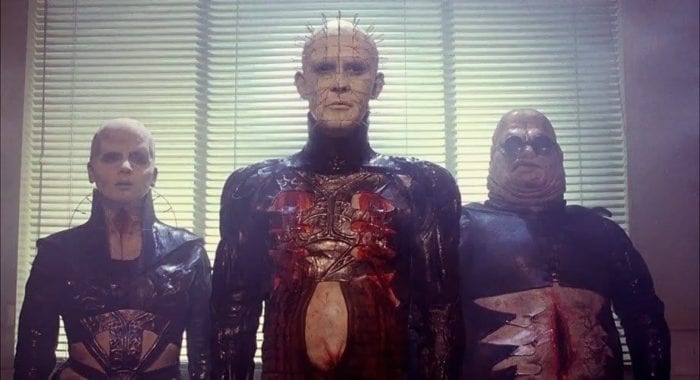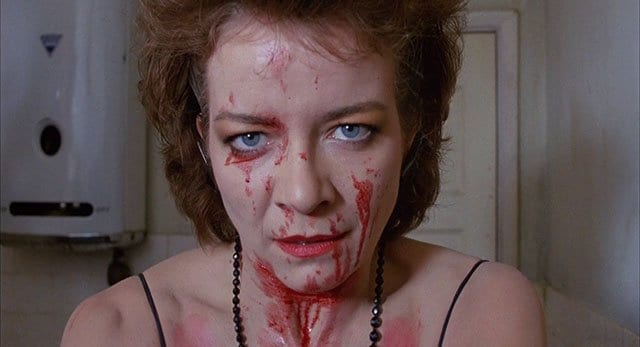There’s a terrible humanity at the hellbound heart of Hellraiser. And the ultimate horror is human. The relatability therein makes it plausible and even when entirely fictive, it feels like something lurking, not just in the shadowy parts of a room, but in the dark depths of every soul. Such horror is inescapably all around us as well as in the mirror. In that vein, what makes this franchise unsettling is the horrifying humanity at the hell-bound heart of Hellraiser.
What makes something horror is difficult to nail down. This is mainly due to individual definitions abounding. Although academically, it could be that “which shocks or even frightens…or perhaps induces a feeling of repulsion or loathing,” those things are often diverse. What scares one person doesn’t necessarily unhinge another, and over time, what once disturbed becomes bland to the gore glutton. Elizabeth Barrette wrote that “the best horror intends to rattle our cages and shake us out of complacency. It…forces us to confront ideas we might rather ignore.” Combining both notions, the Hellraiser franchise emerges as a singular experience. It repulses with gore as well as ideas, a perception of humanity many prefer to ignore.
(Warning! Spoilers peppered throughout.)
Based on a novella by author Clive Barker, the first Hellraiser is one of the better screen adaptations. While that’s partly due to Barker taking the helm as screenwriter and director, it also stems from the film focusing on thematic content as well as imagery. The movie and novella share a look at repressed emotions, feelings, and desires since, like all good horror, these aren’t stories about gore. They just happen to have buckets of blood.

Barker once said, “There’s nothing more dangerous…to the workings of the psyche than the repression of powerfully and genuinely held feelings.”
Much of the franchise, when it works best, operates within this notion. Recapping all ten films would eat up an inordinate amount of time. Suffice it to say: someone finds a mysterious puzzle box, opening it summons the repulsively glamorous Cenobites, and then varying degrees of gory madness ensues. It’s an essentially straightforward formula, yet one brimming with metaphorical potential.
The puzzle box, for instance, contains something an individual seeks. This often means the fulfillment of a desire or expression of a feeling repressed. Some thirst for taboo knowledge, such as Dr. Channard in Hellraiser II¸ while most are content pursuing pleasure. That latter motivation is seen throughout the franchise, from Frank in the first film to J. P. Monroe in the third to Nico in the ninth movie, Revelations. Whatever the desire, a relentless selfish pursuit brings seekers into contact with the Cenobites, extradimensional beings who no longer discern between pleasure and pain. However, in a manner of speaking, the Cenobites are rarely, if at all, the villains.
Especially in the first two films, it’s hard to pin down what exactly is evil about them. Yes, they will tear a person to pieces, but they don’t go around searching for folks to torture. If an individual runs across them, they’ve usually invited these entities into their lives. It isn’t like Hostel where sinister criminals are kidnapping victims. Similar to cosmic horror, the delirium of enthusiasm blinds many to the consequences of their pursuits. The Cenobites are never the cause of but rather the result of someone’s actions.
Throughout the franchise, characters act in a manner dismissive of consequences especially when it comes to the lives and feelings of others. In Hellseeker, a husband opens the box hoping the Cenobites will get rid of his wife. Inferno is a largely surreal exploration of a crooked cop’s guilt over his toxic, hedonistic life. Hellraiser: Deader features a cult leader who attracts damaged individuals he can exploit in his pursuit of the Cenobites’ power. Frank from the first film is perhaps the best example of all this. He seduces his brother’s wife, eventually turns her into a murderer, and skins his own brother, all so he can escape the fate he inflicted on himself.

Through imagery and action, Hellraiser repeatedly presents repulsive scenes, not just of gore but also humanity at its worst. Even so-called heroes are often revealed to be villains in the end. Judgment, for instance, contains the twist that a main character is a serial killer.
Consider Hellraiser: Hellseeker, wherein Kirsty Cotton (Ashley Laurence) escapes from the Cenobites by agreeing to give them five souls. This is the second Faustian bargain she’s made with them, similar to one she proposed in the first film. Still, it’s an interesting take on the trolley problem—one life in exchange for five. One could argue Kirsty only did so to escape being murdered by her husband, however, it still stands to reason, she chose her own life over five people who wronged her. A choice most people would probably make, but that says something unsettling about humanity. That given the right context, it’s possible to justify murder in bulk.
Morally it seems perfectly reasonable but that’s part of the human horror at the heart of the Hellraiser franchise. Everything feels justified to the characters. No one thinks what they’re doing is wrong. To paraphrase John Barth, they’re all the heroes of their own story.

Still, the Cenobites are unique among horror villains in that throughout the majority of films they rarely orchestrate any evil. Hellraiser III perhaps comes closest to Pinhead being the architect of the abhorrent, but for most of the movies, the Cenobites aren’t the cause of anything evil. While they certainly exacerbate matters extremely, they are never the primary reason bad things are happening. That dubious honor falls on the shoulders of human antagonists.
The first Hellraiser is about Frank and Julia murdering people so Frank’s gruesome remains can be restored. Technically, the Cenobites are the heroes for dragging Frank back to Hell. A similar plot runs through the sequel, with Julia resurrected this time, leading Dr. Channard towards corruption. Again, the Cenobites fight the evil doctor at the end. Even in subsequent sequels, whatever wickedness ensues is because humans summoned them. Regarding the Cenobites as the villains is like saying the grenade someone threw is more evil than the person who lobbed it. As such, humanity is the ultimate villain in the Hellraiser franchise.
The creation of the puzzle box which summons the Cenobites explored in Hellraiser: Bloodline is done at the behest of a hedonistic French aristocrat. The entire plot of the Hellworld installment is a grieving father killing those he blames for his son’s suicide. The Cenobites have nothing to do with any of the carnage that happens and only really arrive at the end to kill the vengeful dad. The closest Pinhead gets to a typical slasher is Bloodline where he and the others are racing to prevent their own destruction. Their bloody behavior, in that respect, is borderline self-defense.
Clive Barker said, “We’re all repressing emotions, fantasies, sexual feelings, a whole bunch of excitements because we have to. We can’t just go acting on every impulse that passes through our heads, but we have to address the fact that these things exist.”
The Hellraiser franchise dives into those feelings and desires. Much of the misery that ensues is often the result of someone growing sick with longing for something that’s, for whatever reason, forbidden. They then follow the Wilde aphorism, “the only way to get rid of a temptation is to yield to it.” They kill, seduce, and use others shamelessly. And the ultimate reason why, when all pretense is stripped away, is the self-defeating pursuit of an end to boredom.
Boredom, like horror, can have many definitions. Yet, most orbit the same conception. Boredom can be “the result of predictable experiences” and as such, mean that anything experienced repetitiously enough becomes boring. This monotony leads to a need to seek out novelty. As Emil Cioran wrote in The Trouble with Being Born, “[Humanity] alone, in nature, is incapable of enduring monotony, [humanity] wants something to happen at all costs.” So, endless pleasure would eventually become monotonous resulting in boredom urging the pursuit of any other form of stimulation.
In Sacred Monsters: Behind the Mask of the Horror Actor, Doug Bradley wrote, “I felt now that Pinhead existed in an emotional limbo where neither pain nor pleasure could touch him. A pretty good definition of Hell for me.”
In that regard, the Cenobites are more tragic than monstrous. As revealed in Hellbound: Hellraiser II, they started out human. So, these are essentially exceedingly bored individuals driven to extremes in order to feel the faintest flicker of emotion, and anyone who opens the puzzle box is doomed at best to become one of them. Yet, in a testament to human shortsightedness, that end is something so many happily pursue. At best, there’s a selfishly indulgent desire to experience unfathomable extremes of delight then spend eternity incapable of any feeling whatsoever.

Writer and literary critic Giuseppe Barretti once said, “I hate mankind, for I think myself one of the best of them, and I know how bad I am.”
It’s a line one can easily see spoken by any Hellraiser character, especially the iconic Pinhead. One quote to encapsulate the franchise’s perspective on humanity. One that’s a sad amalgamation of nihilistic misanthropic pessimism wherein the human race is shown all too plainly. That the species is, to varying degrees, a cowardly selfish assortment of pleasure-seekers desperate to escape boredom by almost any means.
Chicago film critic Jonathan Rosenbaum wrote, “don’t expect the movie to linger when it’s over.” It’s the kind of casual dismissal horror fans, unfortunately, expect and yet get a sardonic glee recalling, especially about films that grow into franchises. With ten films to date and a possible tv series in development, Hellraiser certainly continues to linger. Perhaps that’s thanks to horrifying humanity at the hell-bound heart of Hellraiser. Beneath the Sturm Und Drang of leather, hooks, and chains, there’s a terrifying vision of humanity. One that rings hauntingly true.
Looking for more on Hellraiser? We’ve got you:
“Hellbound Hearts: What Makes Hellraiser Queer”
“Behind the Monsters Has Such Sights to Show Your (S1E6)”



